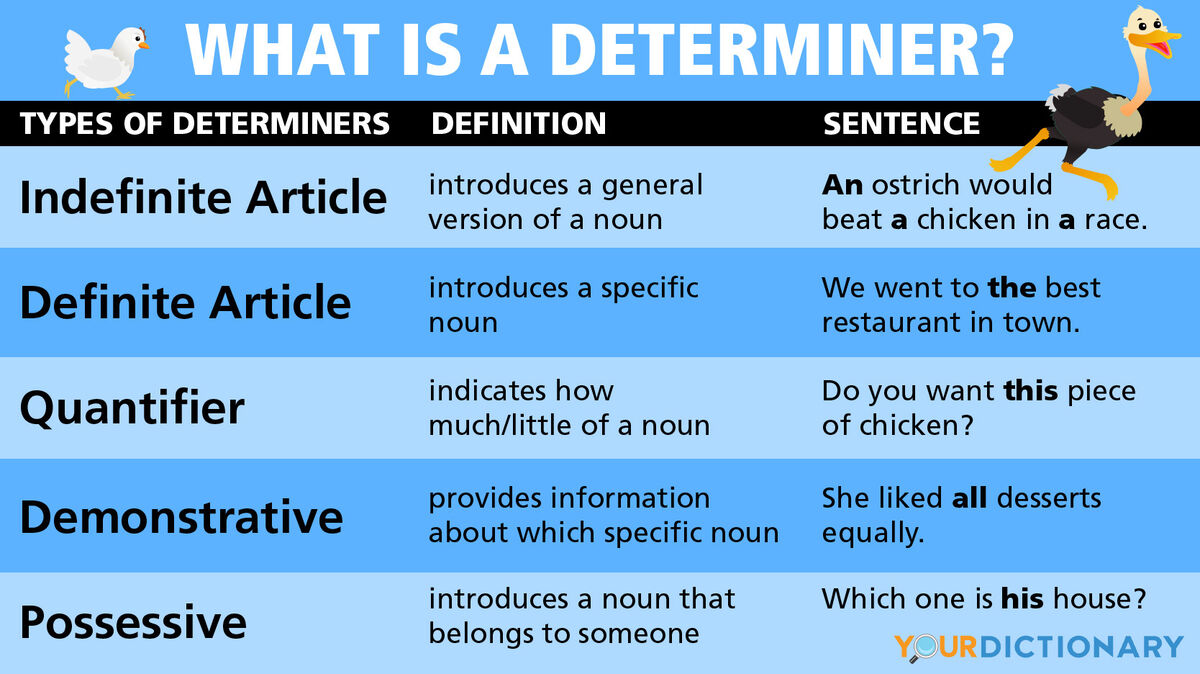
In the English language, we use determiners to provide information about a noun or to introduce a noun. Learn about the different types of determiners through determiner examples.
Determiners Defined
What is a determiner? Simply put, in English, a determiner is a word that introduces a noun or provides information about the quantity of a noun. It always comes before a noun, not after, and it also comes before any other adjectives used to describe the noun. Determiners are required before a singular noun but are optional when it comes to introducing plural nouns.
Determiners Examples
Consider the placement and usage of the common determiner the in the sentences below:
- The bunny went home. (determiner comes directly before the noun)
- I ate the chocolate cookie for dessert. (determiner comes before the adjective chocolate that describes the noun cookie)
- Metal cans are recyclable. (no determiner because it's optional for plural nouns and noun phrases)
- The metal cans are recyclable. (determiner before the adjective describing a plural noun to specify which cans)
In every example, the determiner is placed before the noun or noun phrase, regardless of whether the noun in the subject or predicate.
Types of Determiners
There are four different types of determiners in English: articles, demonstratives, quantifiers, and possessives.
Definite and Indefinite Articles
Articles are among the most common determiners. There are three singular articles: a, an and the. Articles specify (or determine) which noun the speaker is referring to.
A and an are indefinite articles and are used when you are talking about a general version of the noun. A is used before words that begin with consonants while an is used before words beginning with vowels or vowel sounds.
- A dog is a good pet.
- An ostrich would beat a chicken in a race.
- I need an MRI.
- We are to look at a hampster.
In these examples, the sentence is talking about dogs or ostriches in general, meaning any dog. When your meaning is general, use an indefinite article.
On the other hand, the is a definite article, meaning the speaker is referring to a specific noun.
- We went to the best restaurant in town.
- The dog is barking too loudly.
- She didn't like the music.
- We are going to the hospital.
Here the speaker is referring to a particular dog and a particular restaurant. It's not a general category, but only one animal or place that's important. When your meaning is specific, use a definite article.
Demonstratives Examples
Demonstrative pronouns are also used as determiners in English. There are four of them: this, that, these, and those. Demonstratives are used in situations where the speaker can point to the item they mean, making them even more specific than a definite article.
- Do you want this piece of chicken?
- I don't want to go to that movie.
- These black raspberries are sour.
- He wanted those boys to go away.
This and that are singular while these and those are plural.
Determiners as Quantifiers
Quantifiers indicate how much or how little of the noun is being discussed. They include words such as all, few and many.
- He took all the books.
- She liked all desserts equally.
- Few children like lima beans, so the cafeteria stopped serving them.
- Many kittens are taught to hunt by their mothers.
All can be used with other determiners to specify which particular items are meant (i.e. all the books in this pile). In this case, the quantifier always comes before the article or demonstrative. It's also possible to use all alone to refer to items generally, as in the second example.
Possessive Examples
When referring to a noun that belongs to someone or something, you can use possessive pronouns to show ownership. Possessive pronouns include my, your, his, her, its, our, and their.
- Where is your car?
- The dog growled and showed its teeth.
- My best friend is a cat.
- Which one is his house?
- Honesty is her best quality.
- The tree shed its leaves.
- It's our secret recipe.
- Their house was just around the corner.
As always, the determiner comes before the noun and any modifying adjectives. In English, you can use the same possessive whether the noun it references is singular or plural.
Tips for Using Determiners
How should you choose which determiner to use? For native English speakers, determining which determiner to use is second nature, since determiners are so often used in front of nouns. For people learning English as a second language, it's helpful to remember a few rules:
- Determiners always come first in the noun phrase.
- Determiners are required with singular nouns.
- To speak about a singular noun generally, use an indefinite article (a or an).
- To speak about a plural noun generally, do not use a determiner.
- To speak about a singular noun specifically, use a definite article, demonstrative pronoun, possessive pronoun, or quantifier.
- To speak about a plural noun specifically, use a definite article, demonstrative pronoun, possessive pronoun, or quantifier.
Understanding Determiners
Once you learn the dictionary definition of each determiner as you study English vocabulary, it becomes easy to select the determiner that best expresses your meaning, whether you want to show ownership, quantity or relative location. Now that you have a solid grasp of determiners, take a look at what a conjunction is.